 Filling is the process of restoring a tooth with anatomical features in mind. In the modern world, technologies allow to take into account the color, structure and transparency of the surface.
Filling is the process of restoring a tooth with anatomical features in mind. In the modern world, technologies allow to take into account the color, structure and transparency of the surface.
For this procedure in dentistry, specialized restorative or restoration materials are used. They are divided into several species and subspecies, which must meet certain requirements in accordance with its purpose.
Contents
- Classification of filling materials
- What characteristics should the stomatomaterials answer?
- Phosphate and zinc phosphate cement
- Sealing method
- Silicate cement
- Sealing process
- Polymeric materials
- Using acrylic oxide
- Composite material considium
- Installation method
Classification of filling materials
Materials for filling root canals are divided into several directions.
Depending on the tooth group:
- For the front teeth .Must meet cosmetic requirements.
- For chewing teeth .They have high strength and withstand heavy loads.
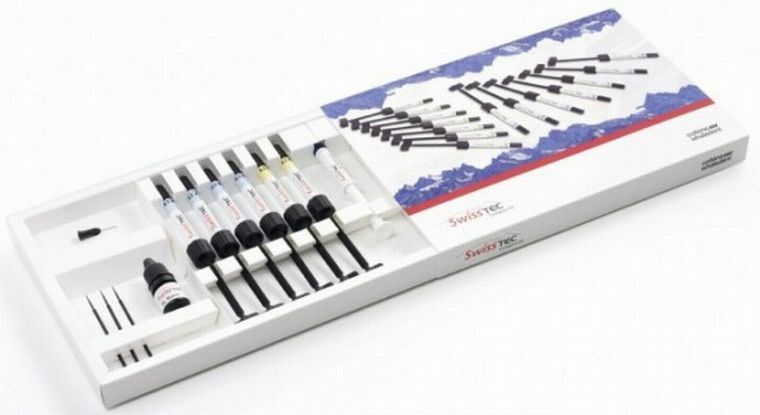
Material for chewing teeth
For the material used in the manufacture of the restoration, there are:
- of metals : amalgams, pure metal, alloys;
- of nonmetals : composite, cement, plastic.
Depending on the purpose of filling materials are divided into:
- for the application of temporary seals and dressings;
- for permanent fillings in the diagnosis of pulpitis;
- gasket if necessary;
- sealing gasket;
- to close the root canal.
The materials used in the manufacture of seals are also separated for their intended purpose.
For temporary seals, the following cements are used:
- zinc sulfate( artificial dentin, dentine paste);
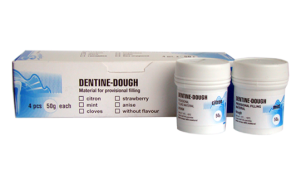
- is zincoginol;
- polycarboxylate;Zinc - phosphate
- ;
- glass ionomer;
- polymer materials.
For insulating gaskets:
- zinc-phosphate cements;
- glass ionomer cements;
- polycarboxylate cements;
- varnishes;
- dentinal bond system.
For medical pads:
- preparations based on calcium hydroxide;
- zinc-eugenol cement;
- materials containing therapeutic additives.

What is Estellate Filling Material and its Uses of Use:
What characteristics should the stoma materials meet?
Requirements for filling materials were developed and approved at the end of the last century by Dr. Miller. In modern dentistry, they almost did not change, minor additions and clarifications were made.
Restorative dental material must comply with the following technological and aesthetic standards:
- To be resistant to the chemical effects of , do not degrade from saliva, oral or dentine fluid, food. Have minimal solubility.
- Withstanding mechanical loads of .In the process of chewing food, there is an impressive pressure: 30 - 70 kg.
- To be resistant to abrasive factors .That is, when chewing or brushing your teeth, do not subject yourself to premature abrasion and repeat the functions of the enamel.
- Correspond to the appearance of the tooth in color, transparency, shape and texture.

- Have good adherence to the walls of the tooth cavity .In addition, the material must be chemically adapted to the tissues or other restorative materials used.
- Be stable, keep the shape and volume of the , thus avoiding shrinkage and for a long time ensuring trouble-free use.
- Do not depend on the moisture of the in the process of filling and solidifying the material.
- To have high handling properties .When working, do not stick to tools, have high plasticity, easily fit into the dental cavity.
- To be biocompatible - do not cause physical harm to the tissues of teeth, pulp, mucous membrane and the body as a whole. Do not contain toxic ingredients, be environmentally friendly for both the medical staff and the patient.
- Prevent caries distribution at the border of the filling and tooth.
- Have a low thermal conductivity of to protect the pulp from irritation when taking hot and cold food. This parameter should be similar to the natural environment of the dental tissue.
- To have radiopaque to provide further control over the condition of the filling and tooth.
- To be minimally easy to use , keep its properties for long-term storage, do not create difficulties in transportation.
Modern technologies have made it possible to come close to meeting these requirements, but still the ideal material is not available at the moment.
For this reason, cases of combining a restoration mixture are quite common in dentistry. Can be used up to 4 different layers, depending on the characteristics of the tooth itself and tissues, location, characteristics of the disease.
In addition, the nature of work with the types of materials differs in the tools used and in the technical process.
The application and technique of working with various filling compositions is curved from the field of application. Consider the most frequently used materials.
Phosphate and zinc-phosphate cement
It has a wide field of application: from permanent seals on baby teeth, followed by isolation with a crown before using as an insulating pad when sealed with other materials.
Sealing procedure
Prepare powder and water. After this, go to the oral cavity. The tooth is isolated from the saliva by using cotton swabs and the cavity is dried by a stream of air.
Phosphate cement is mixed with a chrome plated or nickel plated spatula. Consistency is considered ideal if the mass does not stretch, but breaks, leaving the teeth no higher than 1 mm. The resulting composition is introduced into the cavity of the tooth in small portions, carefully filling the entire space.
It must be noted that the completion of filling and modeling is necessary before the material solidifies. When removing surplus ironing motion should go from the center of the seal to its edges with great care.
When installing an insulating pad, the mixture is applied over the entire surface of the cavity, including the walls, but does not reach the edge of the enamel, as this type of material is quickly absorbed and can cause corrosion of the cavity around the seal.
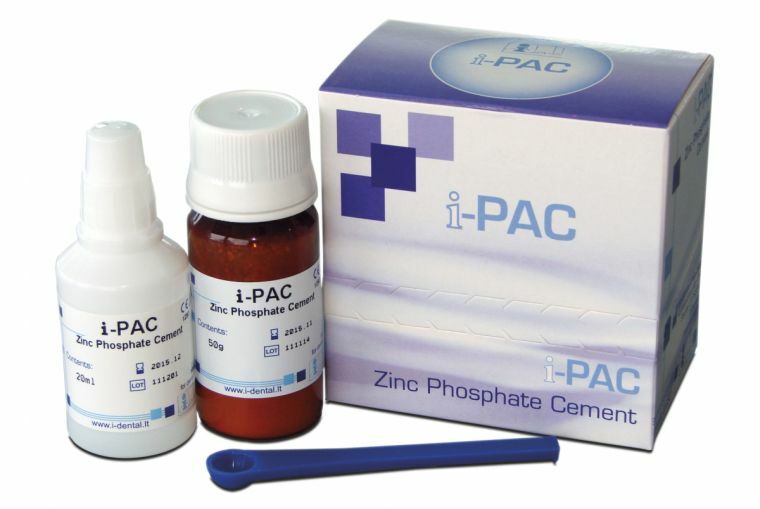
Zinc phosphate cement I-PAC
Silicate cement
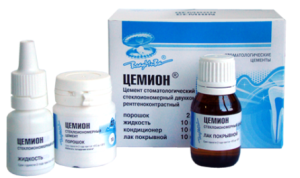 Due to the fact that its composition does not provide sufficient adhesion, and also has a pathogenic effect on the pulp, this operation is carried out only with the installed phosphate cement liner.
Due to the fact that its composition does not provide sufficient adhesion, and also has a pathogenic effect on the pulp, this operation is carried out only with the installed phosphate cement liner.
In the production of an insulating layer, the mixture may be less dense than when sealed, but do not reach a creamy consistency.
After the phosphate cement has dried, it goes over to the application of the base material.
Sealing process
Silicate cement is also mixed with water until a uniform thick mass is formed and introduced into the cavity. It should be noted that when working with this material it is necessary to fill the space in 1, maximum 2 reception.
Since partial filling of the cavity violates the integrity of the seal. Model the shape and remove the surplus necessary before the material dries, since in the solid state it is poorly amenable to eliminating the drawbacks.
The final sealing procedure is to seal the seal with wax, petroleum jelly or varnish.
Polymer materials
Given that this group is aesthetically practical, it is used mainly on the front teeth. The process begins with
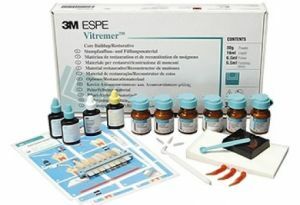
Filling material Vitremer
preparation of the oral cavity, tooth insulation and drying.
When using a polymer, a phosphate pad is also required. Only after its application, a mixture is made from the powder of noracryl and the monomer liquid.
A cellophane film is placed on the glass surface, the required color of the plastic is selected. The powder is applied to the surface and mixed thoroughly with the liquid, the mass is rubbed on the cellophane with wide brush strokes. The procedure of sealing is recommended to be carried out in two stages.
Immediately after mixing, when the consistency of the composite is rather fluid, the first part of the mass is introduced, thereby displacing the air from the cavity and filling the irregularities. After this, the second part is added until it is completely filled.
Modeling takes place at the initial stage of solidification of the material with a trowel. Do not rush to eliminate excess in the elastic state of the composite, so you can break the edge grip.
This material completely hardens within 24 hours. When the patient is again visited, the patient is given a final revision of the seal. In this case, the surfaces of the grinding material must be wetted with water and used at low speed to avoid the heating of the seal.
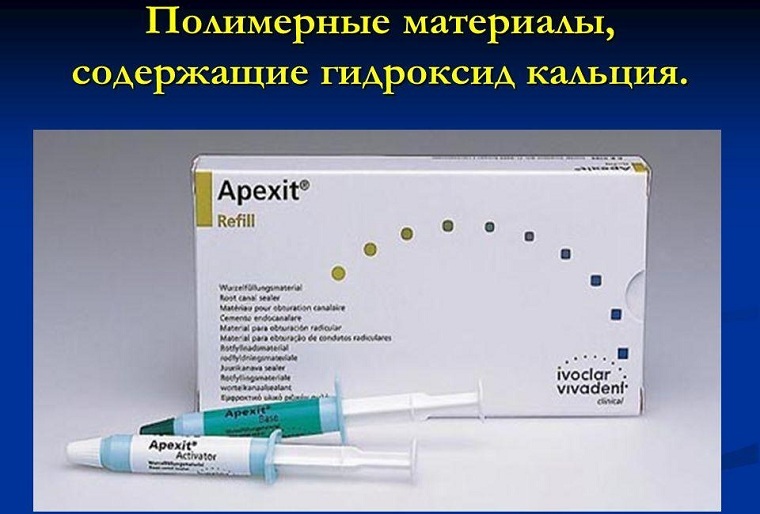
Use of acrylic oxide
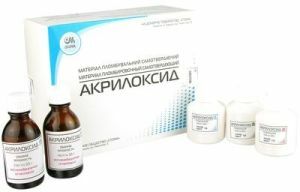 This material has increased resistance to physical and chemical irritants, high adhesion to surfaces and has not lost color for a long time.
This material has increased resistance to physical and chemical irritants, high adhesion to surfaces and has not lost color for a long time.
Insulation liner is applied only in cases of deep caries. After selecting the desired shade, a powder of acrylic oxide is poured into the crucibles.
Cement is mixed according to general requirements, if necessary, gaskets. Then add the liquid to the crucibles and mix for about 50 seconds. In the prepared cavity, a single solution is superimposed with the mass of the solution.
Hardening of the material begins after 1.5 - 2 minutes, during this time it is necessary to conduct the seal simulation. The time for full hardening takes from 8 to 10 minutes. After this, the final stage of machining takes place.
Composite material CONSize
Recently, the recently developed new composite consomming filling material has become popular. It has a high aesthetics, good adhesion to fabrics and other materials.
But considering that with this sealing, the enamel of the tooth is treated with acid, it is absolutely necessary to apply an insulating gasket. The advantage of using this material is the absence of preliminary preparation.
Installation method
The surface is thoroughly cleaned by machining. For 1.5-2 minutes, etch liquid is applied, after which the tooth  is washed with clean water and thoroughly dried.
is washed with clean water and thoroughly dried.
After this process, it must be ensured that the tooth is isolated from the saliva. The etched area will acquire a pretty shade. Then, two equal parts of the liquid filling material are mixed with a swab and applied to the site.
After this, mix two parts of the pre-prepared paste and fill the cavity. In modeling, they use a smoothing iron, and if there are significant defects with a cellophane cap.
Surpluses should be eliminated before the consegment hardens. The hardening of the seal takes up to 8 minutes, after which it is possible to start machining. All materials, including paper napkins and foam rubber tampons, are included.
The article deals with modern filling materials, the most commonly used in dentistry. Before starting the work, it is necessary to carefully determine the degree of the patient's disease and the defect of the teeth.
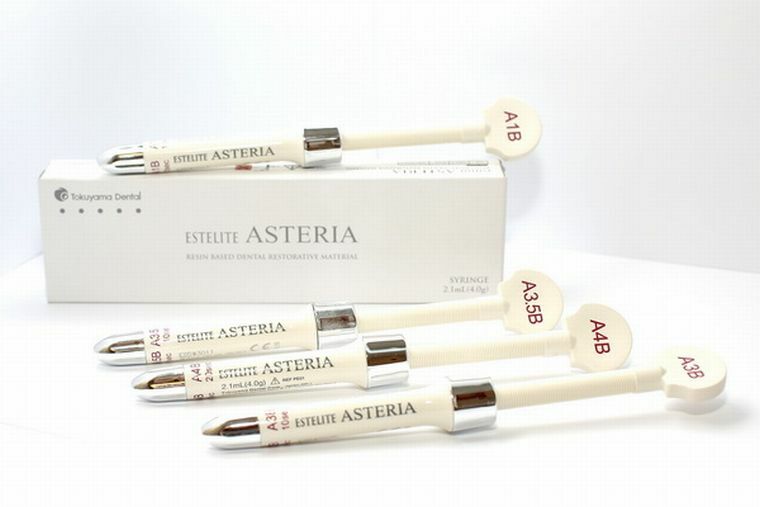
Filling material Estelite
As manufacturers use components with different consistencies in the manufacture of materials, it is necessary to read the instructions before starting the filling. The time of congealing, thickening of the mixture may differ slightly. But with the slightest deviation from the required conditions, the seal may lose the required properties.
